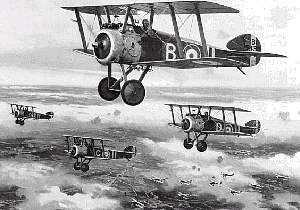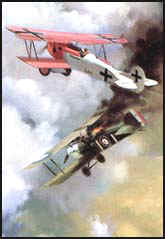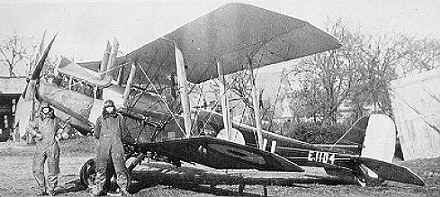 |
|
|||
|
Australian Flying Corps History |
|
 |
|
The original Pilot's Wings for the Australian flyers was the AMF (Australian Military Forces) type. Note the absence of a crown. This is the 1916 version. An earlier (1915) version had a crown and was approved but may not have been manufactured. |
| In January 1916
the British War Office made a special request to the Australian
government.
It wanted 200 volunteers from the AIF to be trained and commissioned as pilots in the Royal Flying Corps. "Exceptionally good work has been done in the RFC by Australian-born officers, and the Australian temperament is specially suited to the flying service," the British note stated. The Australian military leaders approved the request. |
Camels on the Western Front. |
| The first operational
group dispatched was the half-flight sent to the Mesopotamia. Some
excellent reconnaissance work was completed despite poor machines and
appalling conditions. Three of the four pilots were killed or captured
and a number of ground crew were captured at Kut-el Arama and died in
captivity.
The most successful Australian Pilot in British service was Robert Alexander Little from Windsor Victoria. Commissioned into the Royal Naval Air Service late in January 1916, he later became a captain and the 8th top-scoring British ace with 47 enemy fighters shot down. An ace was a flier with five or more victories. Little was awarded the Distinguished Service Order twice and the Distinguished Service Cross twice. He was 22 when shot down and killed on May 27, 1918, while attacking a German bomber.
No. 3 Squadron was the first AFC unit to deploy in France, arriving at Savy on September 10, 1917. It was at once allotted to the newly formed Australian Corps as "corps squadron". In this role it scouted for the Australian Divisions, fought strafing and bombing enemy aircraft, and flew close-observation or contact patrols during the AIF's 1918 battles. The squadrons RE8 aircraft established a astounding record of service. Flying from 10 different aerodromes, they logged 10,000 hours of war flying, fired 500,000 rounds of machine gun ammunition at enemy targets, dropped 6,000 bombs, and accounted for 57 enemy aircraft. Numbers 2 and 4 Squadrons served in an infantry support role with the 80th wing RFC, which became the Royal Air Force in April 1918.
The leading AFC ace was Captain A.H. Cobby, DSO, DFC and two bars, of No. 4 Squadron, who shot down 29 enemy planes and 13 observation balloons. The other two leading AFC aces, also from No.4 Squadron, were Captain E.J.K McCloughry (23 kills) and Captain R. King, DSO, DFC, with 22.5 victories. All flew the Camel. No fewer than 57 Australian pilots became aces. All the Australian squadrons were made up of courageous and colourful men who risked their lives in their flimsy machines every moment they were in the air. Several of them were former ANZACs and many had fought in the trenches in France. Thus they always knew, and appreciated, that their primary task was to help the embattled infantry below. In all, 460 Officers and 2,234 men served in the AFC during the war. |



